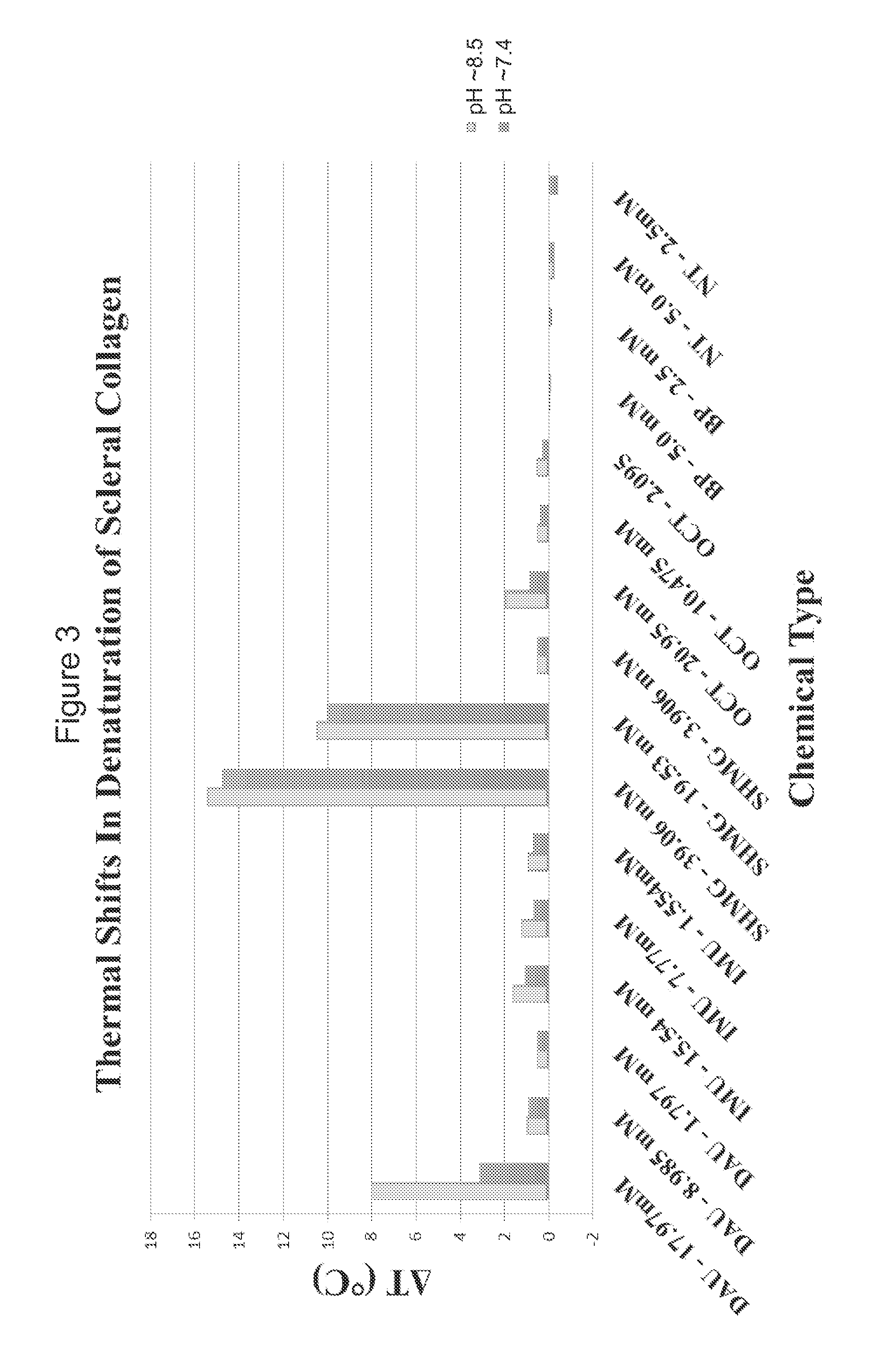Cosmetic preservatives as therapeutic corneoscleral tissue cross-linking agents
- Summary
- Abstract
- Description
- Claims
- Application Information
AI Technical Summary
Benefits of technology
Problems solved by technology
Method used
Image
Examples
examples
First Experimental Details
Cross-Linking Using Formaldehyde Releasing Agents (FARs)
[0047]A listing of formaldehyde releasing agents (FARs) was gathered from literature review. Sixty-four (64) formaldehyde releasing agents, regularly found in cosmetics, were identified from the literature. Each formaldehyde releasing agent was analyzed with respect to relevant characteristics for cross-linking, such as molecular weight, carcinogenicity / mutagenicity, toxicity, hydrophobicity, and commercial availability.
[0048]Based on this analysis, formaldehyde releasing agents were selected for efficacy screening using an ex vivo rabbit corneal cross-linking simulation setup, as described below.
[0049]0.5% proparacaine was applied prior to the cross-linking solution. A cross-linking solution containing the formaldehyde releasing agent was then administered via a corneal reservoir for 30 minutes in 0.1M NaHCO3 at either pH 7.4 or 8.5. The epithelium was left intact. The control contralateral eye was tr...
first experimental details
Example 3
[0070]In a third example of the present invention, several formaldehyde releasing agents were selected and employed in testing. FIG. 3 shows an ex vivo rabbit corneal cross-linking simulation setup used to determine the effects of five selected formaldehyde releasing agents on the thermal stability of collagenous tissue as determined by differential scanning calorimetry (DSC) and measured in upward shifts in thermal denaturation temperature (Tm). The difference in denaturation temperature between treated and paired control (ΔT) represents cross-linking efficacy. The formaldehyde releasing agents tested included N-hydroxymethyl-N-(1,3-di(hydroxymethyl)-2,5-dioxoimidazolidin-4-yl)-N′-hydroxy-methylurea (diazolidinyl urea; labelled DAU), N,N′-methylenebis[N-[3-(hydroxymethyl)-2,5-dioxo-4-imidazolidinyl]]-urea (imidazolidinyl urea; labelled IMU), 5-methyl-1-aza-3,7-dioxabicyclo[3.3.0]octane (labelled OCT), 1,3-dimethylol-5,5-dimethyl-hydantoin (DMDM hydantoin; labelled DMDM), a...
second experimental details
Example 1
Identification of FARs
[0078]From a broad review of the literature, a total of 62 formaldehyde-releasing agents that can potentially be used for corneal and scleral tissue cross-linking were identified. These include FARs commonly found in cosmetics and personal care products as well as those that are used in the textile industry. Table 1 depicts the structures, chemical formulae, toxicity, and other pertinent information of the seven FARs that were chosen for evaluation. None of the chemicals that were tested are known carcinogens. They range in size up to 1,000 mg / kg,) rat oral LD50 values. The exception is BP which has a relatively low LD50 Oral, rat=180 mg / kg.
TABLE 1Characteristics of select FARs pertaining to tissue cross-linking (TXL) in vivo% MaxOctanolAllowedToxicityPartitionConcentration(method,Coefficient(mMspecies, dose,ChemicalStructure(Log P)conversion)Mutagenicityexposure time)Diazolidinyl Urea [DAU; CAS No: 78491-02-8; MW: 278.22 g / mol; Formula: C8H14N4O7]−5.3...
PUM
| Property | Measurement | Unit |
|---|---|---|
| Temperature | aaaaa | aaaaa |
| Temperature | aaaaa | aaaaa |
| Temperature | aaaaa | aaaaa |
Abstract
Description
Claims
Application Information
 Login to View More
Login to View More - R&D
- Intellectual Property
- Life Sciences
- Materials
- Tech Scout
- Unparalleled Data Quality
- Higher Quality Content
- 60% Fewer Hallucinations
Browse by: Latest US Patents, China's latest patents, Technical Efficacy Thesaurus, Application Domain, Technology Topic, Popular Technical Reports.
© 2025 PatSnap. All rights reserved.Legal|Privacy policy|Modern Slavery Act Transparency Statement|Sitemap|About US| Contact US: help@patsnap.com



